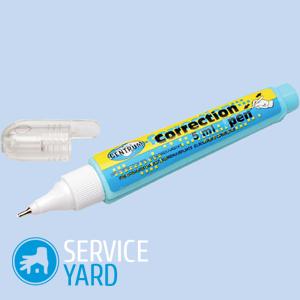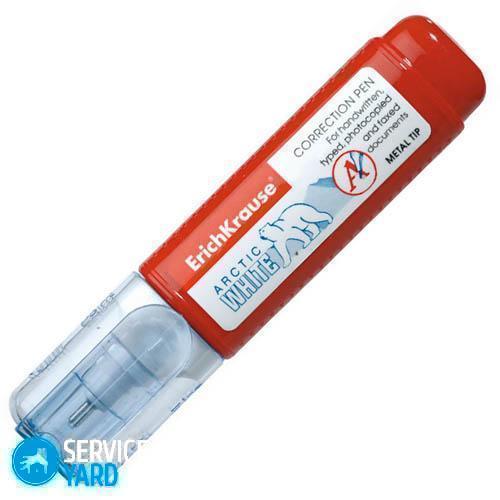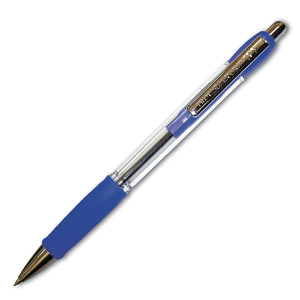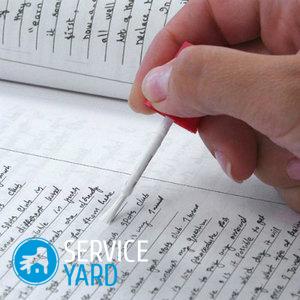How to dilute the corrector?

Office supplies are very popular among schoolchildren, students, office workers, teachers and other people who often have to work with papers and documents. Modern technologies have allowed to create a tool that will facilitate the work as much as possible and help discreetly correct the mistakes made - corrector. But the white liquid tends to dry over time, and then we ask ourselves how to dilute and dilute the corrector at home to maximize its life. In this article we will show you the most effective ways to achieve the desired result.
to contents ↑The whole truth about the corrector
Despite the popularity of this stationery, today there is no universal composition of correction fluid. It is a peculiar trade secret of each specific manufacturer.
However, the following chemicals are present in various proportions in each of the compositions:
- calcium carbonate;
- titanium dioxide;
- highly refined gasoline.
But the most important component is precisely the basis of the corrector, which is known to almost every person who is interested in this issue, because it is indicated directly on the label of this stationery.
Important! If you need to remove any inaccuracy in the document right now, you can use our ideas, how to erase a pen from paper without a trace.
Liquid types of correctors can be divided into the following categories:
- water based;
- with an alcohol component;
- based on emulsion.
Deciding what to dilute the corrector stroke should be, starting from the basis of the substance contained in it.
Water Concealer
Water-based corrective compounds are environmentally friendly and the safest for the human body, and therefore are most popular among schoolchildren. The main advantage of this tool is a good application of the substance on almost any type of paper.
However, as with any product, a water-based bar has its drawbacks - a long drying time. The substance applied to the paper may dry for about a minute, which is quite inconvenient when writing.
Important! It is also worth remembering that such correctors do not tolerate low temperatures well, and therefore undercooling should be avoided during their storage.
Alcohol Bar Concealer
Alcohol-containing corrective compositions are more practical when used than their water-based counterparts - due to almost instant drying. In addition, such products are characterized by increased resistance to freezing.
However, the alcohol-based bar-corrector has a sharp and unpleasant odor, the substance easily ignites, and, accordingly, is dangerous.
Oil-based corrector
The emulsion composition combines all the advantages of alcohol and water type bases. Such a corrector does not have a pungent odor, does not ignite, dries quickly and is absolutely resistant to low temperatures.
However, the cost of such stationery is an order of magnitude higher than that of alcohol or water counterparts. And to find such a tool is quite difficult.
to contents ↑Varieties of proofreaders
Depending on the type of masking layer that is applied to the surface of the paper, the correctors can be divided into dry and liquid. Each of these categories has its own characteristics.
Liquid proofreaders
There are two main types of stationery of this type:
- Correction fluids. Such chemical compositions are sold in small volume bottles and applied to the surface of a paper sheet with a blot using a brush, applicator or a special sponge. Such products are quite convenient and easy to use, however, they are quite rare in modern office, as manufacturers place great emphasis on the production of more practical products.
- Corrector pencil. The shape resembles a conventional pen with a metal tip through which the correction fluid flows out. With the help of such a tool, it is possible to precisely correct even the smallest text details.
Dry proofreaders
This type of stationery is represented by correction tape-roller. This dry composition is quick to use and the ability to continue writing immediately after masking existing blots. The width of the adhesive tape in dry proofreaders is usually 4-6 mm.
Important! Dry proofreaders are quite inconvenient in case of correction on paper with a small line spacing and small print.
So that you don’t have to spend too much time diluting the shrik, and you have to use it often, read a more detailed selection of tips, how to choose a corrector.
to contents ↑How to dilute a dried corrector?
The question of how to dilute a putty stroke if it has dried is quite popular and the solution to this question depends, first of all, on the base used in the production. To dilute the coloring composition, you may need the following liquid substances:
- water;
- alcohol or vodka;
- specialized formulations for diluting the corrector;
- acetone;
- nail polish remover.
Important! When bringing the dried composition into working condition, the main thing is not to overdo it with dilution. Otherwise, you run the risk of getting a white liquid, which will absolutely not paint over blots that are perfect on a sheet of paper, and therefore become useless.
So:
- Water-based proofreaders do not cause any problems at all and are quietly diluted with ordinary tap water.
- To restore the efficiency of alcohol-based products, any product that contains alcohol is suitable. However, it is best to choose the purest alcohol-containing formulations without flavors and colorants. Indeed, excessive impurities can adversely affect the quality of the corrector.
Stock footage
As you can see, do not throw out the corrector if it has thickened. We hope that the tips provided in the article will help you choose the most suitable way how to dilute the stroke, and mistakes made in the texts will be easily and imperceptibly corrected. This is not difficult to do! Good luck






